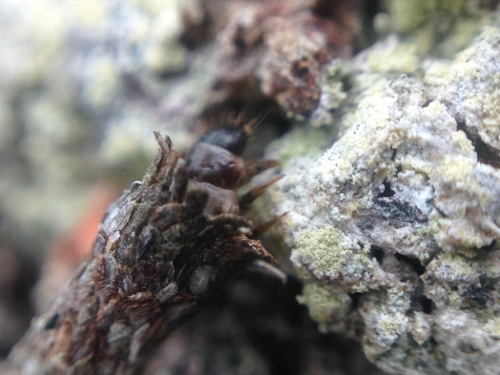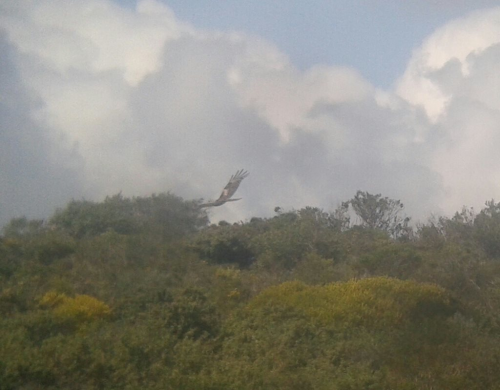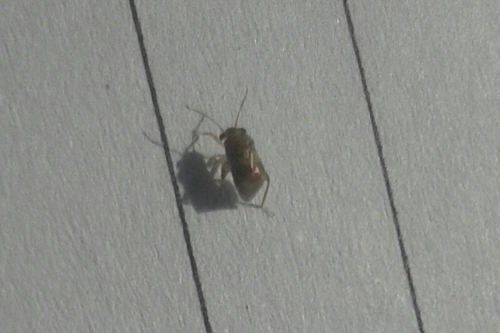#1458 -1466 - A variety of stuff
Large spider under the cut
#1458 - Isopeda leishmanni


A large Huntsman Spider species, with long hair and banded legs. Common in Western Australia and the southern states. One of the Huntsman species pursued by the Giant Spider Wasps in the genus Cryptocheilus. I once saw such a pursuit, high up a tree where the spider was hiding under loose bark. The spider flung itself into the air and fell to the ground, rather than try and face the wasp.
Often found in houses, but usually living under loose bark and hunting at night.
Serpentine, Perth
#1459 - Lepidoscia sp.



One of a genus of Psychid Case Moth caterpillars, with dozens of species in Australia, and more in other parts of the world, although most of the records on iNaturalist are here in Australia. I don’t know how closely that matches their actual distribution. There’s 350 known species of Case Moth in Australia, and going by the Australian Lepidoptera website, most of them are in this genus.
Psychids protect themselves with silken cases, often decorated and reinforced with twigs or dry leaf fragments, and in many species the adult females are wingless, and never leave the case. In at least one, the eggs never leave the mother, either, and her young chew their way out of her as well as the house.
I don’t have much information on the genus, specifically - most of the species I’ve found images of are yellow-winged with dark brown stripes and bands, or mottled grey, as adults, but there’s next to no information on diet.
This particular one I found on my wife’s shoulder, in a wildlife reserve in Coolup, as we were admiring the orchids growing in dense tea-tree scrub. I put it back on the nearest tea-tree, since the lichen-covered trunk of the plant was a close match for the case, apparently covered in fragments of lichen.
#1460 - Cebysa leucotelus - Australian Bagmoth


Photos by Bron King, in Canberra, Australian Capital Territory. Here’s another, also in Canberra, by Erin Renfield.

One of Australia’s large range of Case Moths, and certainly one of the most remarkable. The female is the metallic blue and flame-orange one. She’s flightless, like the majority of female Psychids, but can run around with startling speed and agility. Males can fly normally.
A lichen-feeding species, found over most of Australia, and despite the common name, also in New Zealand.
#1460 - Pison sp.

A small black and silver Sand Wasp (Fam. Crabronidae) that I spotted exploring a sand bank in Capel, in Australia’s SW corner. Possibly she was looking for a good place to excavate a burrow, but she may have been looking for spiders as well.
There are some 145 described species, although many species, especially in South America have yet to be named. Most species are found in the tropics and Southern Hemisphere, and at least a third of the known species are found in Australia. At least one researcher, in 1916, thought this meant they’d been out-competed by more aggressive wasp species in the Northern Hemisphere, but that’s exactly the kind of bullshit conclusion Eurocentric bias can lead you to.
Pison wasps raise their young on a diet of living but paralysed spiders. While many species construct large mud nests in caves or tree hollows, others use hollow plant stems, beetle burrows, abandoned bird nests, or dig their own tunnels. Typically, multiple spiders-and-egg cells will be placed adjacent to one another, with each cell is sealed off from adjoining eggs with mud or dung pellets. Since a number of species will nest inside artificial structures like keyholes, or holes in wood, a few have been widely dispersed by humans.
#1461 - Lophoictinia isura - Square-tailed Kite


Being harrassed by crows, over Karnup, south of Perth.
Squared-tailed Kites are widespread across Australia, but habitat destruction has lead to them become endangered in South Australia, vulnerable in Victoria, and rare in Queensland. Usually seen singly, the Square-tailed Kite is sometimes seen soaring in pairs during the breeding season, and family groups of adults and one or two dependent young may be seen during post-fledging period.

The Square-tailed Kite usually hunts low over the treetops, as in my photo here, plunging down through the foliage to snatch a birds or large insect from among the leaves. Nestlings are one common prey item, sometimes removing the entire nest to get at the young birds, or carrying them off one in each foot. Adult birds may also be ambushed. They’re also known to eat snails and reptiles.
Courtship behaviour includes acrobatic displays, rolling over to present claws, but actual breeding time various according to the local climate. In the tropics, that’s usually April, but in more temperate regions it might be any time between July and February.
#1462 - Coridromius sp. Mirid Bug


A tiny bug from the Miridae family, that once showed up on my daily worklist.
They’re a mostly tropical genus, with dozens of species. One has successfully spread across the southern US. About the only noteworthy thing I know about them is that they’re one of the invertebrates that practices traumatic insemination - although, presumably, the females would prefer that they didn’t practise it at all, and took up consensual BDSM instead. Traumatic insemination is rare in most animal groups, but oddly prevalent in the true bug infraorder Cimicomorpha (Heteroptera), where it occurs in six families, and arose independently at least three times.
Baldivis, Perth
#1463 - Amblyomma triguttatum - Ornate Kangaroo Tick

Most likely A. t. trigattatum, since that seems to be the most common of the four subspecies, at least in Western Australia. Amblyomma is a genus of hard tick, found worldwide, and includes a number of known disease vectors. This one, for example is a known vector of Rickettsia, and suspected of involvement in Q Fever.
This particular individual scrambled across the sand towards my boots, while I was working on a building. Not entirely surprising - there are dozens of kangaroos that hang around the same subdivision, eating the lawns. They’ve been found on rats and rabbits too.
Dawesville, south of Perth
#1464 - Cochlicella acuta - Pointed Snail

Found on beach buildings in the middle of a huge expanse of intact bushland, down at Cape Leeuwin in the SW corner. Not native to Australia, unfortunately.
Originally native to parts of Europe including Spain, France, Belgium, the Netherlands and the British Isles, living in dunes, sandhills, and grassy downs close to the sea. It is extremely abundant in some areas, but gets even more so when it’s an invasive species with no predators. That including in Greece, Israel, Egypt, and Australia.
This species does well on sandy calcareous soils, and often prefers a coastal setting such as sand dunes. Probably explains why it does so well here. It aestivates, avoiding dry hot weather, by attaching itself to vertical surfaces such as fence posts, tall weeds, or in this case a wall.
It’s an agricultural pest here, not because it eats living crops, but because it contaminates grain. The parasitic flesh-fly Sarcophaga pencillata, which targets this species and the Small pointed snail Prietocella barbara, was introduced into South Australia from Europe during 2001-3, but there’s no evidence to suggest this actually worked.
#1465 - Gastrinodes argoplaca - Cryptic Bark Moth

AKA Selidosema argoplaca.
A geometrid moth that feeds on gum trees, found over most of mainland Australia. There’s no real reason it wouldn’t be found in Tasmania, either.
Found on my front porch here in Wellard, Perth.
#1466 - Australotilla sp.

One of Australia’s many ‘velvet ants’, wasps in which the females are wingless and often have a powerful sting.
The taxonomy of Australia’s Mutillidae is badly in need of revision, but the last person who came to Australia to work on them went home again before they’d much headway into the enormous task.
Spotted clambering around on the ground out at Waroona, SW of Perth, probably sniffing around for a burrowing insect to parasitise.
#1458 - Isopeda leishmanni


A large Huntsman Spider species, with long hair and banded legs. Common in Western Australia and the southern states. One of the Huntsman species pursued by the Giant Spider Wasps in the genus Cryptocheilus. I once saw such a pursuit, high up a tree where the spider was hiding under loose bark. The spider flung itself into the air and fell to the ground, rather than try and face the wasp.
Often found in houses, but usually living under loose bark and hunting at night.
Serpentine, Perth
#1459 - Lepidoscia sp.



One of a genus of Psychid Case Moth caterpillars, with dozens of species in Australia, and more in other parts of the world, although most of the records on iNaturalist are here in Australia. I don’t know how closely that matches their actual distribution. There’s 350 known species of Case Moth in Australia, and going by the Australian Lepidoptera website, most of them are in this genus.
Psychids protect themselves with silken cases, often decorated and reinforced with twigs or dry leaf fragments, and in many species the adult females are wingless, and never leave the case. In at least one, the eggs never leave the mother, either, and her young chew their way out of her as well as the house.
I don’t have much information on the genus, specifically - most of the species I’ve found images of are yellow-winged with dark brown stripes and bands, or mottled grey, as adults, but there’s next to no information on diet.
This particular one I found on my wife’s shoulder, in a wildlife reserve in Coolup, as we were admiring the orchids growing in dense tea-tree scrub. I put it back on the nearest tea-tree, since the lichen-covered trunk of the plant was a close match for the case, apparently covered in fragments of lichen.
#1460 - Cebysa leucotelus - Australian Bagmoth


Photos by Bron King, in Canberra, Australian Capital Territory. Here’s another, also in Canberra, by Erin Renfield.

One of Australia’s large range of Case Moths, and certainly one of the most remarkable. The female is the metallic blue and flame-orange one. She’s flightless, like the majority of female Psychids, but can run around with startling speed and agility. Males can fly normally.
A lichen-feeding species, found over most of Australia, and despite the common name, also in New Zealand.
#1460 - Pison sp.

A small black and silver Sand Wasp (Fam. Crabronidae) that I spotted exploring a sand bank in Capel, in Australia’s SW corner. Possibly she was looking for a good place to excavate a burrow, but she may have been looking for spiders as well.
There are some 145 described species, although many species, especially in South America have yet to be named. Most species are found in the tropics and Southern Hemisphere, and at least a third of the known species are found in Australia. At least one researcher, in 1916, thought this meant they’d been out-competed by more aggressive wasp species in the Northern Hemisphere, but that’s exactly the kind of bullshit conclusion Eurocentric bias can lead you to.
Pison wasps raise their young on a diet of living but paralysed spiders. While many species construct large mud nests in caves or tree hollows, others use hollow plant stems, beetle burrows, abandoned bird nests, or dig their own tunnels. Typically, multiple spiders-and-egg cells will be placed adjacent to one another, with each cell is sealed off from adjoining eggs with mud or dung pellets. Since a number of species will nest inside artificial structures like keyholes, or holes in wood, a few have been widely dispersed by humans.
#1461 - Lophoictinia isura - Square-tailed Kite


Being harrassed by crows, over Karnup, south of Perth.
Squared-tailed Kites are widespread across Australia, but habitat destruction has lead to them become endangered in South Australia, vulnerable in Victoria, and rare in Queensland. Usually seen singly, the Square-tailed Kite is sometimes seen soaring in pairs during the breeding season, and family groups of adults and one or two dependent young may be seen during post-fledging period.

The Square-tailed Kite usually hunts low over the treetops, as in my photo here, plunging down through the foliage to snatch a birds or large insect from among the leaves. Nestlings are one common prey item, sometimes removing the entire nest to get at the young birds, or carrying them off one in each foot. Adult birds may also be ambushed. They’re also known to eat snails and reptiles.
Courtship behaviour includes acrobatic displays, rolling over to present claws, but actual breeding time various according to the local climate. In the tropics, that’s usually April, but in more temperate regions it might be any time between July and February.
#1462 - Coridromius sp. Mirid Bug


A tiny bug from the Miridae family, that once showed up on my daily worklist.
They’re a mostly tropical genus, with dozens of species. One has successfully spread across the southern US. About the only noteworthy thing I know about them is that they’re one of the invertebrates that practices traumatic insemination - although, presumably, the females would prefer that they didn’t practise it at all, and took up consensual BDSM instead. Traumatic insemination is rare in most animal groups, but oddly prevalent in the true bug infraorder Cimicomorpha (Heteroptera), where it occurs in six families, and arose independently at least three times.
Baldivis, Perth
#1463 - Amblyomma triguttatum - Ornate Kangaroo Tick

Most likely A. t. trigattatum, since that seems to be the most common of the four subspecies, at least in Western Australia. Amblyomma is a genus of hard tick, found worldwide, and includes a number of known disease vectors. This one, for example is a known vector of Rickettsia, and suspected of involvement in Q Fever.
This particular individual scrambled across the sand towards my boots, while I was working on a building. Not entirely surprising - there are dozens of kangaroos that hang around the same subdivision, eating the lawns. They’ve been found on rats and rabbits too.
Dawesville, south of Perth
#1464 - Cochlicella acuta - Pointed Snail

Found on beach buildings in the middle of a huge expanse of intact bushland, down at Cape Leeuwin in the SW corner. Not native to Australia, unfortunately.
Originally native to parts of Europe including Spain, France, Belgium, the Netherlands and the British Isles, living in dunes, sandhills, and grassy downs close to the sea. It is extremely abundant in some areas, but gets even more so when it’s an invasive species with no predators. That including in Greece, Israel, Egypt, and Australia.
This species does well on sandy calcareous soils, and often prefers a coastal setting such as sand dunes. Probably explains why it does so well here. It aestivates, avoiding dry hot weather, by attaching itself to vertical surfaces such as fence posts, tall weeds, or in this case a wall.
It’s an agricultural pest here, not because it eats living crops, but because it contaminates grain. The parasitic flesh-fly Sarcophaga pencillata, which targets this species and the Small pointed snail Prietocella barbara, was introduced into South Australia from Europe during 2001-3, but there’s no evidence to suggest this actually worked.
#1465 - Gastrinodes argoplaca - Cryptic Bark Moth

AKA Selidosema argoplaca.
A geometrid moth that feeds on gum trees, found over most of mainland Australia. There’s no real reason it wouldn’t be found in Tasmania, either.
Found on my front porch here in Wellard, Perth.
#1466 - Australotilla sp.

One of Australia’s many ‘velvet ants’, wasps in which the females are wingless and often have a powerful sting.
The taxonomy of Australia’s Mutillidae is badly in need of revision, but the last person who came to Australia to work on them went home again before they’d much headway into the enormous task.
Spotted clambering around on the ground out at Waroona, SW of Perth, probably sniffing around for a burrowing insect to parasitise.